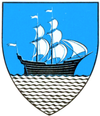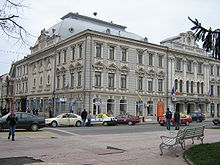- Brăila
-
Brăila The Danube in Brăila 
Coat of armsLocation of Brăila
Coordinates: 45°16′09.1″N 27°57′26.9″E / 45.269194°N 27.957472°ECoordinates: 45°16′09.1″N 27°57′26.9″E / 45.269194°N 27.957472°E Country  Romania
RomaniaCounty Brăila County Status County capital Government – Mayor Aurel Gabriel Simionescu (Social Democratic Party) Area – Total 33.2 km2 (12.8 sq mi) Population (est. 2010)[1] – Total 210,245 – Density 6,382/km2 (16,529.3/sq mi) Time zone EET (UTC+2) – Summer (DST) EEST (UTC+3) Website http://www.primariabraila.ro/ Brăila (Romanian pronunciation: [brəˈila] (
 listen); Greek: Μπράιλα; Turkish: İbrail) is a city in Muntenia, eastern Romania, a port on the Danube and the capital of Brăila County, in the close vicinity of Galaţi.
listen); Greek: Μπράιλα; Turkish: İbrail) is a city in Muntenia, eastern Romania, a port on the Danube and the capital of Brăila County, in the close vicinity of Galaţi.According to the 2002 Romanian census there were 216,292 people living within the city of Brăila,[2] making it the 10th most populous city in Romania.
Contents
History
A settlement at this location on the left bank of the Danube, in Wallachia, was mentioned with the name Drinago in a Spanish Libro de conoscimiento ("Book of knowledge", circa 1350) and in several Catalan portolan charts (Angelino de Dalorto, 1325/1330 and Angelino Dulcert, 1339). This may have been an erroneous transcription of Brillago. In Greek documents of roughly that time, the city is referred to as Proilabum or Proilava, a Greek language adaptation of its Slavic name, Brailov. In German language sources, it is mentioned as Uebereyl. The origin and meaning of the name is unknown.
As a kaza, the town and its surrounding area was controlled by Ottoman Turks from 1538–1540 until 1829 (it was restored to Wallachia through the Akkerman Convention); the Ottomans called it Ibrail or Ibraila.
Brăila was attacked, plundered, and set fire to by the forces of Moldavian Prince Stephen the Great on February 2, 1470, during the retaliation campaign against Wallachian Prince Radu the Fair, who had allied himself with the Ottomans. It was briefly ruled by Michael the Brave, prince of Wallachia (1595–1596).
During the 19th century, the port became one of the three most important ports on the Danube in Wallachia, the other two being Turnu and Giurgiu. The city's greatest period of prosperity was at the end of the 19th century and in the early 20th century, when it was an important port for most of the merchandise coming in and going out of Romania.
After the 1989 Revolution, Brăila entered a period of economic decline.
Demographics
Historical population of Brăila Year Population %± 1900 58,392[3] — 1912 census 65,053[4] 11.4% 1930 census 68,347 5% 1948 census 95,514 39.7% 1956 census 102,500 7.3% 1966 census 138,802 35.4% 1977 census 194,633 40.2% 1992 census 234,110 20.2% 2002 census 216,292 −7.6% 2007 estimate 215,316[5] −0.4% According to the last census, from 2002, there were 216,292 people living within the city of Brăila.[6] The ethnic makeup is as follows:
For 2010, Brăila has an estimated population of 210,245.[1]
Metropolitan area
Economy
Accessible to small and medium-sized oceangoing ships, Brăila has large grain-handling and warehousing facilities. It is also an important industrial center, with metalworking, textile, food-processing, and other factories.
Cityscape
Brăila has the following areas: Centru (Center), Viziru (1, 2, 3), Călăraşi 4, Ansamblul Buzăului, Radu Negru, Obor, Hipodrom, Lacu Dulce, Dorobanţi, 1 Mai, Comorofca, Calea Galaţi, Gării, Apollo, Siret, Pisc, Brăiliţa, Vidin-Progresul, Islaz and Chercea.
Landmarks
Streets radiating from near the port towards Brăila's center are crossed at symmetrical intervals by concentric streets following the geometric design of the old Ottoman fortifications.
The old center of the city has many 19th century buildings, some of them fully restored. The most important monuments are the Greek Church, erected at 1865 by the Greek community, the Sfinţii Arhangheli Church, former jāmi during the Ottoman rule (until 1831), the 19th century Sfântul Nicolae Church, also from the 19th century, the Maria Filotti theatre, the Palace of Culture and its Art Museum, the History Museum, and the old Water Tower. The latter houses a restaurant and a rotation system (360° in one hour).
Another important site is the Public Garden, a park situated above the bank of the Danube with a view over the river and the Măcin Mountains. Early in 2006 the municipality received European Union funds to renovate the old center of the city, aiming to transform Brăila into a major tourist attraction of Muntenia.
The Church of the Holy Archangels is the oldest in the city. Begun in 1667, the former mosque was transformed into an Orthodox Church in 1808.
Transport
Brăila features one of the oldest electrical tram lines in Romania, inaugurated at the end of the 19th century and still in use. Brăila's bus system is operated by the town hall in cooperation with Braicar Company, with four primary bus configurations available servicing most of the city.
Local media
The city has several local newspapers, including Obiectiv-Vocea Brăilei, Monitorul de Brăila, Ziarul de Brăila and Arcaşu'. It also has three television stations: Mega TV, and the local stations of Antena 1 and Pro TV, and in 2009 ArenaTV established a regional production office.
Natives
- Nicu Alifantis
- Petre Andrei
- Ana Aslan
- Anton Bacalbaşa
- Beatrice Căslaru
- Anişoara Cuşmir-Stanciu
- Hariclea Darclée
- Anton Dumitriu
- Constantin von Economo
- Andreas Embirikos
- Maria Filotti
- Liviu Floda
- Nae Ionescu
- Panait Istrati
- Joseph M. Juran
- Antigone Kefala
- Manea Mănescu
- Gheorghe Mihoc
- Mina Minovici
- Diana Mocanu
- Jean Moscopol
- Serge Moscovici
- Gheorghe Munteanu Murgoci
- Valeriu Niculescu
- Perpessicius
- Gheorghe Petraşcu
- Camelia Potec
- Johnny Răducanu
- Mihail Sebastian
- Tudorel Stoica
- Vasilica Tastaman
- Christos Tsaganeas
- Ilarie Voronca
- Iannis Xenakis
- Ionut- Catalin Banica
- Florin Valeriu Mihalache
International relations
Twin towns - sister cities
Brăila is twinned with:
 Pleven in Bulgaria.
Pleven in Bulgaria. Calais in France.
Calais in France. Argostoli in Greece.
Argostoli in Greece. Katerini in Greece.
Katerini in Greece. Bitola in Macedonia.
Bitola in Macedonia. Kavadarci in Macedonia.
Kavadarci in Macedonia. Denizli in Turkey.
Denizli in Turkey. Nilüfer in Turkey.
Nilüfer in Turkey.
Image gallery
External links
- (Romanian) Brăila Online
- (Romanian) Interactive map of Brăila
- (Romanian) Brăila online
Notes
- ^ a b "Largest Romanian cities in 2010" (in Romanian). evz.ro. August 28, 2011. http://www.evz.ro/detalii/stiri/iasi-sau-timisoara-care-este-cel-de-al-doilea-mare-oras-din-romania-dupa-bucuresti-943339.html. Retrieved August 28, 2011.
- ^ 2002 Census
- ^ Encyclopædia Britannica Eleventh Edition
- ^ A Handbook of Roumania
- ^ Romania in Cifre-2008 (Romanian)
- ^ "Ethno-demographic Structure of Romania". The Ethnocultural Diversity Resource Center. http://www.edrc.ro/recensamant.jsp?regiune_id=503&judet_id=504&localitate_id=505. Retrieved January 02, 2011.
Brăila County, Romania Cities Brăila (county seat)
Towns Communes Bărăganul · Berteştii de Jos · Bordei Verde · Cazasu · Chiscani · Ciocile · Cireşu · Dudeşti · Frecăţei · Galbenu · Gemenele · Grădiştea · Gropeni · Jirlău · Măraşu · Măxineni · Mircea Vodă · Movila Miresii · Racoviţa · Râmnicelu · Romanu · Roşiori · Salcia Tudor · Scorţaru Nou · Siliştea · Stăncuţa · Surdila-Găiseanca · Surdila-Greci · Şuţeşti · Tichileşti · Traian · Tudor Vladimirescu · Tufeşti · Ulmu · Unirea · Vădeni · Victoria · Vişani · Viziru · Zăvoaia
250,000+ 100,000+ Ploiești · Brăila · Oradea · Bacău · Arad · Pitești · Sibiu · Târgu Mureș · Baia Mare · Buzău · Satu Mare · Botoșani · Râmnicu Vâlcea · Suceava · Piatra Neamț · Drobeta-Turnu Severin · Focșani
County seats of Romania (alphabetical order by county) Alba Iulia • Arad • Piteşti • Bacău • Oradea • Bistriţa • Botoşani • Braşov • Brăila • Buzău • Reşiţa • Călăraşi • Cluj-Napoca • Constanţa • Sfântu Gheorghe • Târgovişte • Craiova • Galaţi • Giurgiu • Târgu Jiu • Miercurea-Ciuc • Deva • Slobozia • Iaşi • Buftea • Baia Mare • Drobeta-Turnu Severin • Târgu Mureş • Piatra Neamţ • Slatina • Ploieşti • Satu Mare • Zalău • Sibiu • Suceava • Alexandria • Timișoara • Tulcea • Vaslui • Râmnicu Vâlcea • Focşani
Bucharest (national capital)
Galaţi County Brăila County Tulcea County Măcin • I.C. Brătianu • Garvăn
The Danube Countries 
Cities Tributaries Islands Categories:- Brăila
- Cities of Romania served by tramway systems
- Populated places on the Danube
- Populated places in Brăila County
- Cities in Romania
Wikimedia Foundation. 2010.













